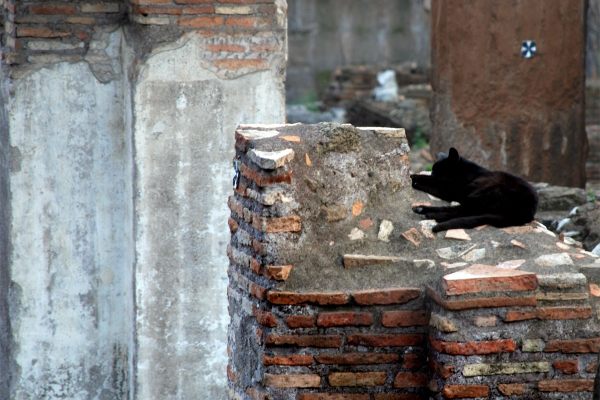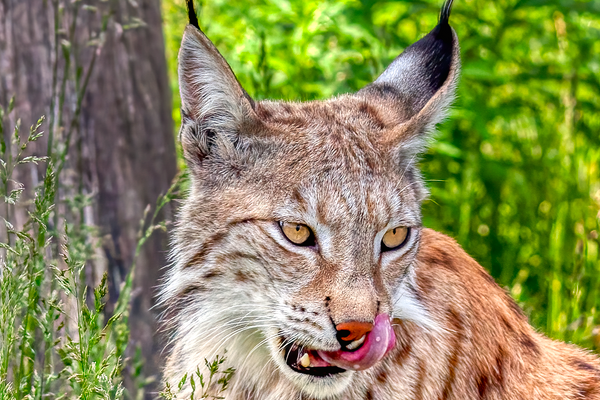Eight Cat Paradises, Where the Felines Come First
From the religious cat cult of ancient Egypt, to the booming popularity of modern Japanese cat cafes, it’s clear that the human fascination with cats is a far from new concept. With all the fuss made over felines, it hardly comes as a surprise that there are several locations dedicated exclusively to their well being and entertainment.
Below are eight sites where cats are king:
CAT ISLAND
Tashirojima, Japan
Cat Island kitty (photograph by Nakae/Flickr)
The small Japanese Island of Tashirojima is well-deserving of its nickname: “Cat Island.” Stray cats were originally brought to island to aid in protecting silkworms from predatory mice. However, the locals formed a kinship with the felines, and the cats’ importance grew long after the silk trade ended.
At present, the island’s population of feral cats massively dwarfs its human population of only 100. Islanders believe that feeding the cats brings good fortune, and fishermen feel the cats can help in predicting fish and weather patterns. As a result, in Tashirojima cats hold a high status. Dogs have been effectively banned, and the copious cat tours and exhibitions have made the tiny island an unlikely tourist stop for feline lovers. The cats have even made an impact on Japanese pop culture after a movie and series were based on a Tashirojima stray nicknamed “Droopy-Eared Jack.” A paradise indeed.
A cat shrine on Cat Island (photograph by Kakei.R/Flickr)
Cat Island resident (photograph by Nakae/Flickr)
ERNEST HEMINGWAY HOUSE & MUSEUM
Key West, Florida
Cat at the Hemingway House (via Florida Keys Public Libraries)
Ernest Hemingway: writer, adventurer, bon vivant, world traveler, bastion of manliness, and felinophile. The Ernest Hemingway Home and Museum was the main residence for the legendary author for nearly a decade, often cited as the location for some of his most prolific years as a writer. However, the home is also a tourist draw due to the abundance of felines of the polydactyl variety.
Story goes, Hemingway was given a white six-toed cat by a ship’s captain. A lifelong cat lover, Papa Hemingway named the cat Snowball and let the tomcat run amok on his Florida estate. Today, one can see the results of Snowball’s romantic exploits in the form of the 40 plus cats that call the grounds home, the majority of them with extra digits. The cats range in breed and temperament, but following a tradition started by Hemingway, all of them are named after famous contemporaries of the author.
Ernest Hemingway with his sons & cats in Cuba (1942) (via Ernest Hemingway Photograph Collection, John F. Kennedy Presidential Library)
Hemingway cat cemetery (photograph by Ray Smith/Flickr)
Cat sleeping in Hemingway’s former bedroom (photograph by Roger Wollstadt/Flickr)
DE POEZENBOOT
Amsterdam, Netherlands
View of De Poezenboot in an Amsterdam canal (photograph by Jorge Royan/Wikimedia)
What do you do if your passion for taking in stray cats and kittens causes your home to overflow with felines? If you’re Henriette van Weelde, the obvious choice is to buy the cats their own houseboat.
Founded in 1966, De Poezenboot — which translates simply to “Cat Boat” — is a floating cat sanctuary on Amsterdam’s Herengracht Canal. While cats and water are typically not an ideal combination, the residents of the Cat Boat seem blissfully unaware of their wet surroundings as they receive food and veterinary care inside their floating home. The boat houses up to 50 cats at a time and serves as a means to get many of its furry inhabitants adopted into loving homes. Around 14 of the cats remain as permanent residents, the most dominant of which is named Koeienkat — translated to Cowcat — a surly black and white male that serves as the ship’s honorary captain, or cat-pain.
A welcome sign for the Poezenboot (photograph by Shadowgate/Flickr)
Kitty passenger (photograph by Heidi De Vries/Flickr)
THE STRAY CAT HOSTEL
Istanbul, Turkey
Stray Cat Hostel (via hostelstraycat.com)
Stray cats in Turkey’s imperial capitol are afforded a respect that alludes felines elsewhere. The predominantly Muslim population there holds cats in high regard. As a popular adage goes, “if you’ve killed a cat, you need to build a mosque to be forgiven by God,” and over the years stray cats have become a much beloved icon of Istanbul city life.
As homage to the felines that roam their streets, the Stray Cat Hostel offers itself as a whimsical lodging for cats and human alike. Its common areas are covered in cat artwork, and the seating is taken up freely by resident felines.
INTHAR HERITAGE HOUSE
Lake Inle, Burma
Cats roaming at Inthar Heritage House (photograph by butforthesky.com)
Once the royal cats of palaces and the guardians of temples, in contemporary times the Burmese pedigree cat has become a rarity in its homeland. In an attempt to preserve and revive this majestic breed, the Inthar Heritage House in Myanmar has become a permanent residence to over 50 purebred Burmese cats. The cats are free to roam both their indoor “sanctuary” and their outdoor “cat village,” both of which are flanked by copious toys and contraptions to keep them occupied.
Shipped in from Australia and the UK, the cats at the house serve as not only as a means to further the breed and reintroduce them to Myanmar, but also a venue to let people appreciate the beauty and grace of the cats. Visitors are welcome to get coffee at the onsite cat café and mingle with the animals, provided they show them the respect mandated by their regal pedigree.
Inthar Heritage House (photograph by butforthesky.com)
Burmese cats lounge at the Inthar Heritage House (photograph by butforthesky.com)
CAT VILLAGE
Houtong, Taiwan
Capturing the beauty of the cats in Houtong, Taiwan (photograph by Hsu Luke/Flickr)
At one time a prosperous coal-mining town, by the mid 2000s Houtong had fallen into severe decline. As the town’s human residents dwindled out, the empty streets became home to an increasing population of stray cats. In 2008, a local Houtong cat lover enlisted volunteers to aid in feeding the city’s abundant strays, posting photos and videos of Houtong’s felines online to garner support. In the tradition of Keyboard Cat and Lil’ Bub, the Houtong cats ended up becoming a viral sensation and the small town became a must-see destination for cat lovers.
Houtong has fully embraced its newfound status, or cat-us, and a series of cat-themed souvenir shops, bakeries, and cafés have provided a much-needed boost to the town’s economy. The notoriously friendly Houtong cats thrive on the attention they get from visitors and the main bridge to the town now includes a special elevated wooden “catwalk” so that the cats can personally greet tourists arriving by train.
A cat overlooking Houtong (photograph by Dickson Phua/Flickr)
Cat houses in Houtong (photograph by P1340/Wikimedia)
CHORA
Mykonos, Greece
A cat in Chora (photograph by Chris Booth/Flickr)
The temperate beaches and whitewashed streets of Chora, a picturesque Greek beach town, have long been a frequent haunt for stray cats, but the locals have not always considered the feral animals a welcome sight. Recently the town’s inhabitants indulged their feline inhabitants, much to the delight of tourists.
In Chora every street has an accompanying feline mascot, and every corner offers a cat photo op. The formerly neglected strays of Chora have been reinvented as celebrities. The cats have even been immortalized in a coffee table book full of candid shots of the famous felines.
Cat in the old section of Chora (photograph by Random_fotos/Flickr)
Sleeping cat in Chora (photograph by Luigi Rosa/Flickr)
LARGO DI TOREE ARGENTINA
Rome, Italy
Cat at the Torre Argentina sanctuary (photograph by Andrea Schaffer/Flickr)
Located in the Campis Martius, the ancient square of Largo di Torre Argentina was uncovered by Mussolini’s reconstruction efforts in the late 1920s. A landmark rich in history, the square hosts the remains of four holy temples, as well as the infamous “Theater of Pompey,” the site of Julius Caesar’s brutal assassination. Shortly after the site was excavated, it unwittingly became a safe haven for Rome’s large feral cat population, where the felines thrived off the attention of the local gattare, or Italian cat ladies. One of these women was legendary Italian actress Anna Magnani, who famously spent her breaks from filming at the nearby Teatro feeding the cats.
The cats’ influence over the area became so great that the Torre Argentina, a no-kill sanctuary for the cats, was founded. Today, it serves as a home for over 250 needy cats and kittens. Cared for by volunteers, the felines are given food and medical care as they lounge and sun on the ancient ruins while awaiting adoption.
Cat at the Torre Argentina Cat Sanctuary (photograph by Vix_B/Flickr)
View of the cat sanctuary (photograph by Seth Pipkin/Flickr)
For more fine felines, check out Atlas Obscura’s compendium of cat places >


















Follow us on Twitter to get the latest on the world's hidden wonders.
Like us on Facebook to get the latest on the world's hidden wonders.
Follow us on Twitter Like us on Facebook